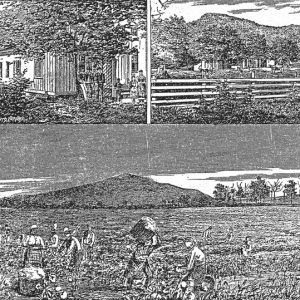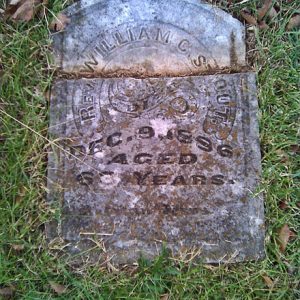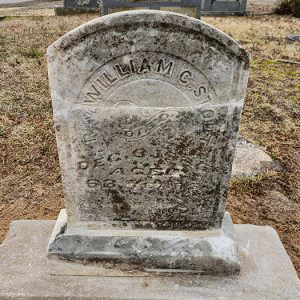calsfoundation@cals.org
William C. Stout (1824–1886)
The clergyman William Cummins Stout was the master of two large antebellum plantations at the foot of Petit Jean Mountain in Conway County and the “first Arkansas man ordained to the priesthood of the Episcopal Church in Arkansas,” according to church records.
William Stout was born in Greene County, Tennessee, on February 18, 1824. His parents, John G. Stout and Mary Kirby Stout, moved with their children to Fayetteville (Washington County) in 1830, where they continued their farming occupation. While a young man working in a store near the Indian Territory line, Stout attended meetings conducted by Bishop Leonidas Polk and discerned a religious calling. With Polk’s encouragement, Stout received his education at Kemper College in Missouri, then Nashotah House in Wisconsin for three years, before entering Virginia Seminary, where he completed his studies and was ordained deacon in 1847.
Upon his return to Arkansas, he served at St. Paul’s in Fayetteville, which he established as a parish in 1848. On May 31, 1849, he was ordained a priest in Van Buren (Crawford County) but shortly thereafter moved south for his health, working with groups in Camden (Ouachita County) and El Dorado (Union County) that were preparing for organization in the church. In 1850, he moved to Marshall County, Mississippi, where he married Mary Elizabeth Jordan, the daughter of a successful planter and merchant; they had eight children, five of whom survived to adulthood.
In the mid-1850s, Stout journeyed to Conway and Perry counties to purchase land for a plantation. In 1855, Stout bought a thousand acres along both sides of the Arkansas River beginning at the east end of Petit Jean Mountain. Employing a large contingent of slaves, the Stouts built Hawkstone Plantation on the south bank and Fairfields Plantation on the north, ultimately owning perhaps 5,000 acres. The Stouts made Arkansas their home in 1858, with Stout soon assigned as acting rector of Christ Church in Little Rock (Pulaski County). The family shortly moved to Hawkstone Plantation, which featured a chapel in which Stout conducted services for the area’s Episcopalians, including the plantation’s slaves. The Stouts also maintained a home in Little Rock, where Reverend Stout continued his duties at Christ Church, splitting his time among Hawkstone, the capital, and various congregations around the state.
When the Civil War broke out in 1861, the Stouts stored 766 bales of cotton and 39,000 pounds of cottonseed and also planted corn, wheat, oats, and tobacco. In early 1863, guerrillas, claiming the authority of the Confederacy, confiscated forty-two bales of the stored cotton. Later that year, Stout took the majority of the family’s slaves (151 according to the 1860 slave census) and fled to Texas for the duration of the war, leaving his wife and children at their Little Rock home. Shortly thereafter, the Fiftieth Illinois Infantry arrived at nearby Lewisburg (Conway County) and seized both plantations. Union soldiers subsequently bivouacked there, killing livestock, appropriating tobacco and cotton, and destroying machinery and buildings.
Following the Stouts’ return to their ruined plantations, they set to work rebuilding. In 1868, Stout sailed to British Honduras to assess the environment for settlement, as other well-to-do former citizens of the Confederacy did at the time. Unimpressed, he came back to Hawkstone.
Southern Conway County boomed with the construction of the Little Rock and Fort Smith Railroad in the early 1870s, and Stout, with not only plantations on both sides of the river but also a ferry across from what was then Perry County to railroad access at Morrilton (Conway County), stood in a formidable position to influence the growing region. He began a newspaper, The Weekly State, in 1874 in Lewisburg, which moved to Morrilton in 1878, briefly became the Clipper and then the Headlight, in which form it exists today.
Stout continued to serve Episcopal communities as a preacher throughout the central Arkansas River Valley for the rest of his life. He played an active part in the establishment of an Episcopal diocese in Arkansas and held various diocesan-level offices.
In 1875, Stout became a member of the Board of Visitors of the Arkansas Industrial University, now the University of Arkansas (UA) in Fayetteville, and state manager in preparation for the United States Centennial celebration. As an avocational naturalist, Stout received and filled requests from the Smithsonian Institution and other scientific enterprises to provide Arkansas specimens of reptiles, amphibians, mammals, and Indian artifacts. He wrote scholarly articles for the Arkansas Gazette, including series on “The French in Arkansas” and “Mound-builders of Arkansas.”
Besides its steamboat landing and ferry, Hawkstone soon boasted stores, a lumber mill, and a post office, in which Stout served as postmaster. By 1886, Hawkstone had become a bustling little community at the foot of Petit Jean Mountain.
Stout died on December 9, 1886. He is buried in Morrilton’s Elmwood Cemetery, but his name lives on in the landscape in Stout’s Point, on the east end of Petit Jean Mountain overlooking the former location of Hawkstone, and Stout’s Gap, a break in the southern Petit Jean bluff line. The Episcopal Diocese of Arkansas holds title to both places, which form a part of the church’s Camp Mitchell.
For additional information:
Cantrell, Ellen Harrell. The Annals of Christ Church Parish of Little Rock Arkansas, from A. D. 1839 to A. D. 1899. Little Rock: Arkansas Democrat Co., 1900.
Hand-book of the Arkansas River Valley in Arkansas Along the “Valley Route” between Van Buren and Little Rock. Chicago: C. S. Burch Publishing Company, 1887.
Historical Reminiscences and Biographical Memoirs of Conway County, Arkansas. Van Buren, AR: Press-Argus, 1967.
McDonald, Margaret Simms. White Already to Harvest: The Episcopal Church in Arkansas, 1838–1971. Episcopal Diocese of Arkansas, 1975.
Simmons, Donald C. Confederate Settlements in British Honduras. Jefferson, NC: McFarland and Company Publishers, 2001.
Donald Higgins
Petit Jean Mountain, Arkansas










Comments
No comments on this entry yet.